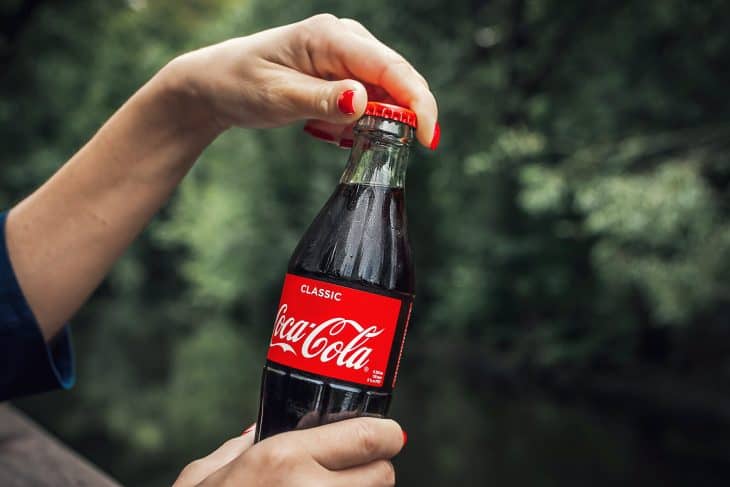
- John Stith Pemberton invented Coca-Cola.
- John Stith Pemberton was an American biochemist and Civil War veteran.
- During the 19th century, Coca-Cola is first marketed to the alcohol-free bar.
- The alcohol-free bar business focuses on social occasions such as weddings.
- In contrast to the ‘hard drinks’ which means an alcoholic drink – the term ‘soft drinks’ means a non-alcoholic beverage.
- The word Coca-Cola came from the word coca leaves, and kola nuts.
- Coca is a cultivated plant in the family of Erythroxylaceae – a family of flowering trees and shrubs.
- The kola nut is the fruit of the kola tree that contains caffeine. These kola nuts are native to the tropical rainforests of Africa.
- To this date, the Coca-Cola formula remains to be a trade secret.
- To protect Coca-Cola’s historic formula, the company is only selling the Coca-Cola syrup on its bottlers.
- Coca-Cola bottlers around the world do not produce the beverage from scratch. Hence, these bottlers simply combine the concentrate with filtered water and sweeteners.
- The Coca-Cola Company of Atlanta is the producer of Coca-Cola syrup.
- In the United States, the main ingredient in the formula is high-fructose corn syrup 55. Furthermore, its called ’55’ since it contains 55% corn syrup.
- At the time of Coca-Cola’s invention, cocaine was legal and a common ingredient in medicines. Thus, the first Coca-Cola products contain cocaine as part of its ingredients.
- Although the company believed that cocaine is not harmful in small doses, in the year 1929, the company removed all traces of cocaine due to public pressure against the substance.
- John Pemberton advertised Coca-Cola as a patent medicine, claiming that it cured headaches, upset stomach, and fatigue.
- John Stith Pemberton developed the beverage in the year 1886.
- Unfortunately, John Pemberton became ill and nearly bankrupt. As a result, he sold his rights to the formula in his business partners in Atlanta.
- John Pemberton left some of the company shares to his son. However, his son sold the remaining portion for $1,750 – equivalent to $47,300 in today’s money.
- The term Coke is the product of the Coca-Cola Company. Furthermore, Coca-Cola also owns other popular drinks like Sprite, Minute Maid, Powerade and so much more.
Coca-Cola Facts Infographics
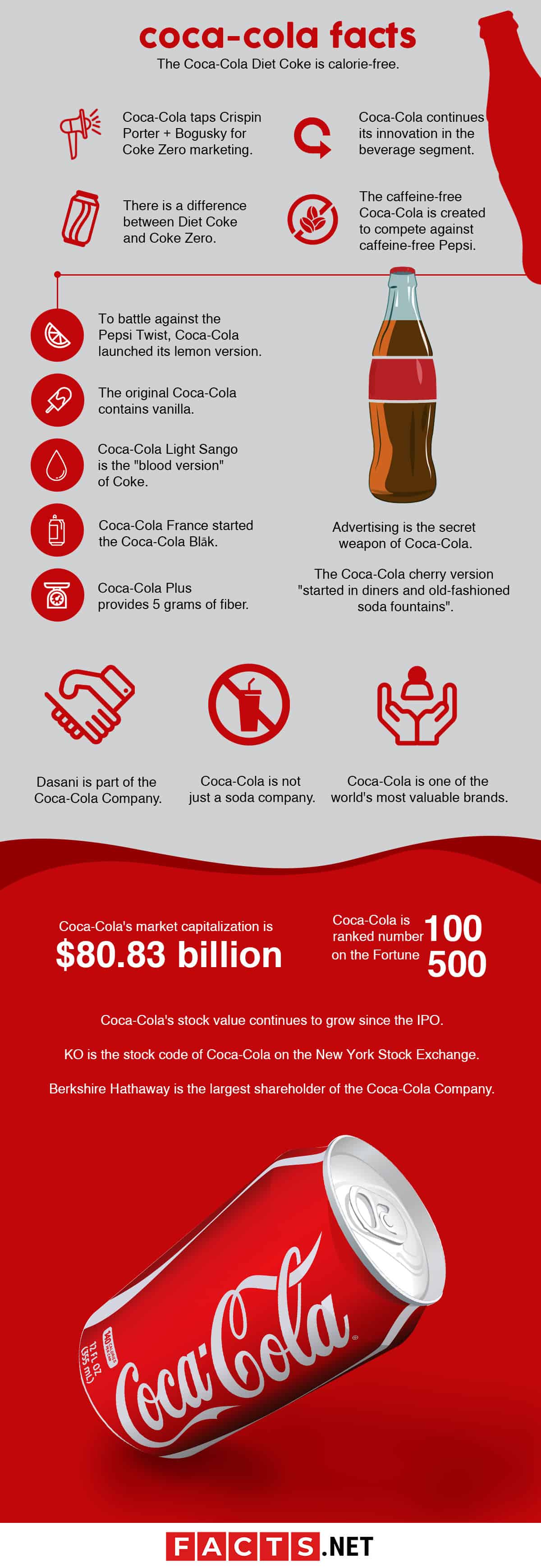
The Coca-Cola Diet Coke is calorie-free.
The Coca-Cola Diet Coke is a sugar-free and zero-calorie soft drink. Accordingly, the company removes sugar from its ingredients, so as to remove the calorie count in the equation, and substitutes it with artificial sweeteners such as aspartame.
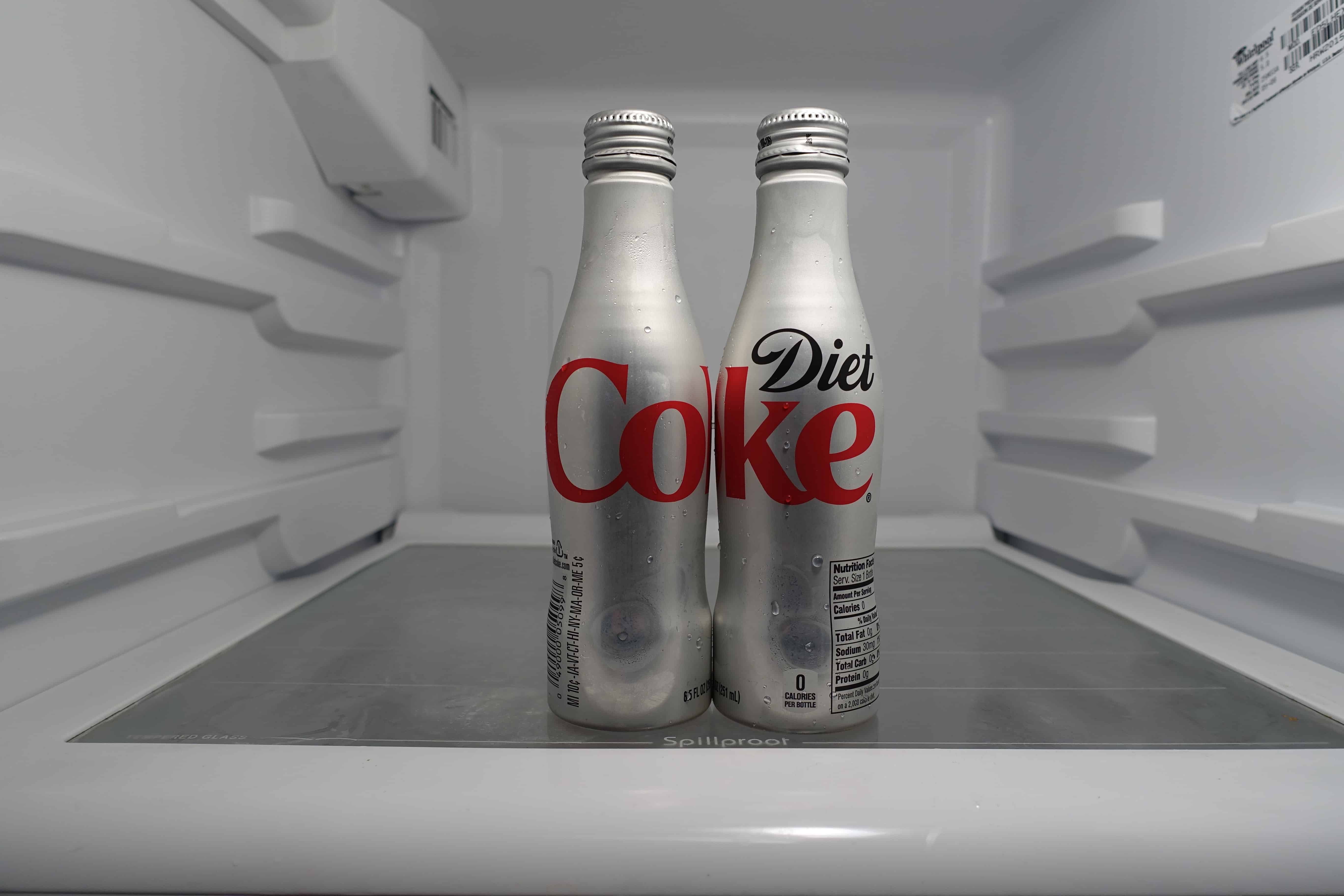
Coca-Cola taps Crispin Porter + Bogusky for Coke Zero marketing.
Coca-Cola Zero Sugar or also known as Coke Zero is was introduced in 2005 as a new no-calorie cola. Coke is the largest product launch by the company in 22 years which was done by a creative agency, Crispin Porter + Bogusky. In particular, Crispin Porter + Bogusky is an advertising company that has hundreds of employees who are headquartered in Boulder, Colorado with offices numerous in Asia and Europe.
There is a difference between Diet Coke and Coke Zero.
If there is already a Cola-Cola Diet Coke, why is there Coke Zero? What is the difference? Diet Coke and Coke Zero have one thing in common—to give the consumers a carbonated drink with zero-calorie. However, their main difference is taste. In particular, Diet Coke has a lighter taste than the original Coke while Coke Zero mimics Coke’s original taste.
The caffeine-free Coca-Cola is created to compete against caffeine-free Pepsi.
Although one of Coke’s signature ingredients is the kola nuts which contain caffeine, the company also created its caffeine-free version. Furthermore, the company decided to bring this new product back in the year 1983 to compete against its rival Pepsi that offers caffeine-free Pepsi.
Coca-Cola continues its innovation in the beverage segment.
Caffeine-free Coca-Cola Zero is also available in the market today, which was introduced in America in 2013. With this in mind, consumers can compare the original caffeine-free Coca-Cola which has 140 calories in a 12-fluid-ounce, containing 45 mg of sodium and 39g of sugar, versus the caffeine-free Coca-Cola Zero which they promote as
- Real coke taste with zero calories.
- Caffeine-free.
- Perfect size for drinking with meals, on the go, or any time.
- “It’s possible”
The Coca-Cola cherry version "started in diners and old-fashioned soda fountains".
Coca-Cola Cherry is a cherry-flavored version of Coca-Cola. Furthermore, diners and old-fashioned soda fountains used to add a cherry on Coke even before Cherry Coke was invented by the company. Hence, the company saw the opportunity to create something out of it and Cherry Coke then entered mainstream production in the United States during the summer of 1985.
The original Coca-Cola contains vanilla.
Coca-Cola Vanilla is a vanilla-flavored version of Coke that was introduced in the year 2002. Arguably one of the best-tasting Coca-Cola flavors, Vanilla Coke has almost the same ingredients as the original flavor since Coca-Cola already contains small amounts of vanilla and all they have to do is enhance its flavor.
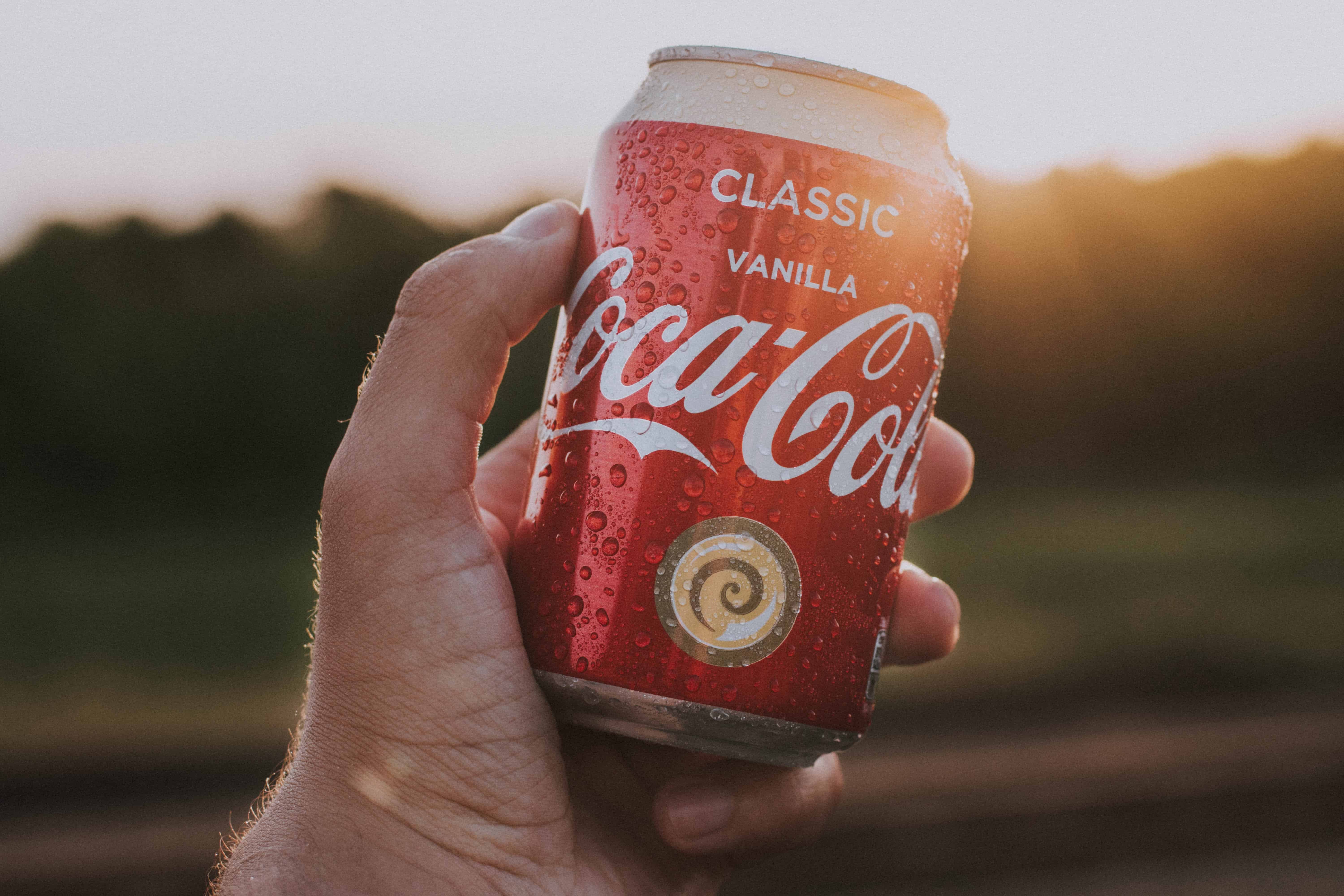
To battle against the Pepsi Twist, Coca-Cola launched its lemon version.
Coca-Cola with Lemon—a zingy take on the original Coke, Coca-Cola with Lemon was launched in the United States in the year 2001 due to consumer requests, and to battle with Pepsi Twist as well. Soon after, Diet Coke Lemon was also launched to provide a “healthier” option for those who are reducing calories or sugar intake.
Coca-Cola Light Sango is the "blood version" of Coke.
Available in France since the year 2005, the Coca-Cola Light Sango is one of the most unique Coca-Cola flavors. The Coca-Cola Light Sango’s name is based on the word “sang”, which means blood in French, which is inspired by its blood-orange taste and color. Furthermore, the first product ever developed outside Atlanta is the Coca-Cola Light Sango.
Coca-Cola France started the Coca-Cola Blāk.
Speaking of Coca-Cola France, it also entered the coffee market segment in the country and went as far as Canada and the United States in the year 2006. Moreover, advertised as “the sophisticated taste Coca-Cola Blāk builds a new occasion ritual – the afternoon break” received its breakout and also infiltrated other countries like the Czech Republic, Slovakia, Lithuania, and even some parts of Asia.
Coca-Cola Plus provides 5 grams of fiber.
Due to Japan’s healthy eating culture, the company created the Coca-Cola Plus for them. Moreover, Coca-Cola Plus provides 5 grams of dietary fiber which they promote to reduce fat absorption from food.
Coca-Cola is not just a soda company.
Coca-Cola has a product portfolio of more than 3,500 types of beverages. The company continues to innovate the beverage industry with many flavors—Coca-Cola Orange, Catechin, Life, Ginger, Clear, Mexican Coke, Apple, etc, as well as sports drinks, fruit drinks, and even regular bottled water just to name a few.
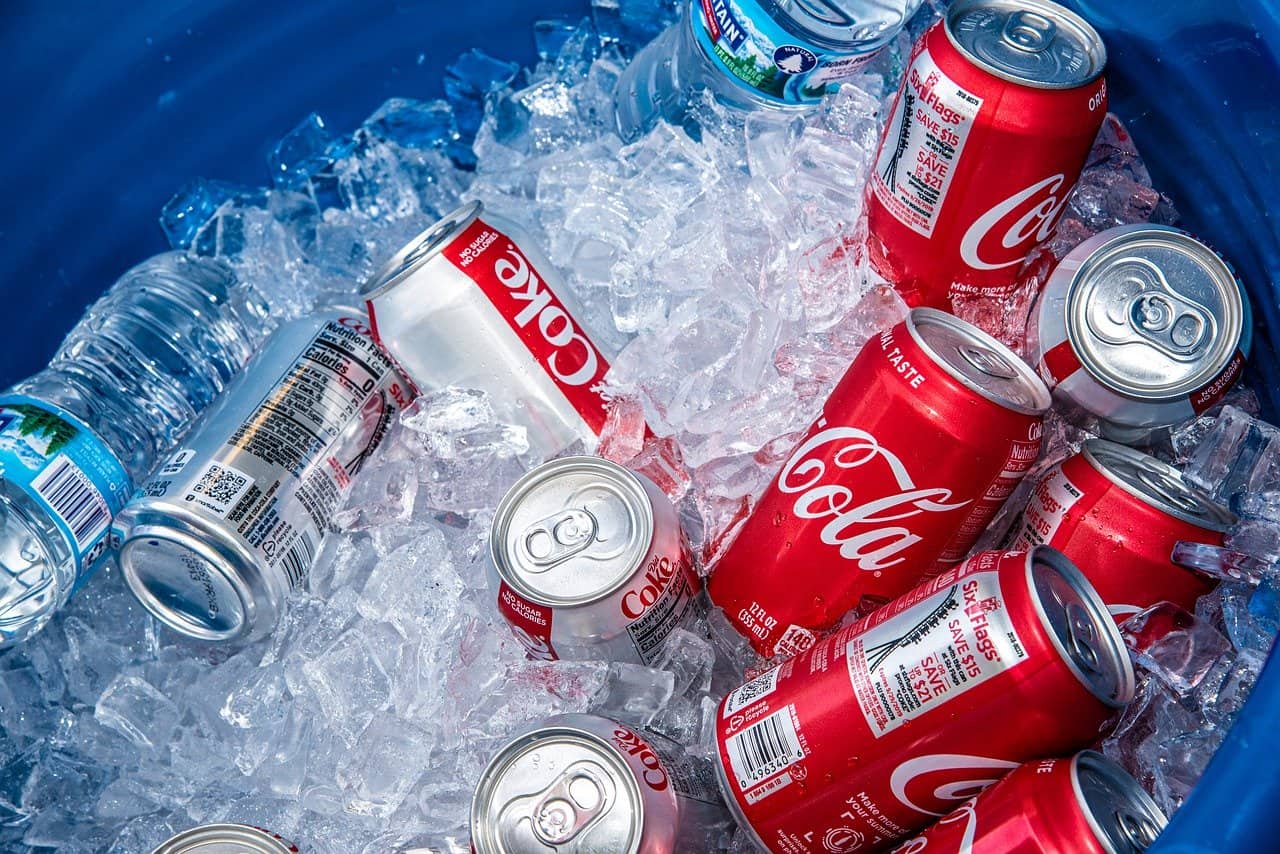
Dasani is part of the Coca-Cola Company.
Dasani is the bottled water product of Coca-Cola. In contrast to Pepsi’s success in the bottled water market (Aquafina), Coca-Cola would not let themselves fall behind. Today, Dasani is a recognized brand all over the world even though some may not be aware that Dasani is actually part of the Coca-Cola company.
Coca-Cola is one of the world's most valuable brands.
Coke products today are sold in over 200 countries. Furthermore, the company is one of the world’s most valuable brand inline with the tech giants Apple and Google based on Interbrand’s “best global brand”.
Coca-Cola is ranked number 100 on the Fortune 500.
The Fortune 500 is an annual list compiled and published by Fortune magazine and ranks the top 500 corporations based on the total revenue for their fiscal years. Currently, Coca-Cola is in 100th place with a revenue of $31 billion. Fun fact: Walmart topped the list.
Coca-Cola's market capitalization is $80.83 billion.
As of the end of the year 2019, Coca-Cola’s market capitalization (the market value of a publicly-traded company’s outstanding shares) is $80.83 billion. Equally important, the company’s advertising strategy is one of the reasons why the Coca-Cola brand is recognizable and dominant across the planet.
Advertising is the secret weapon of Coca-Cola.
On average, Coca-Cola spends $900 million on advertising in the United States alone. Moreover, a staggering $4 billion is the total advertising cost of Coca-Cola globally every year. Nevertheless, the company sees advertising costs as an investment rather than a liability. Even more, they also love to sponsor several sports events as part of the marketing strategy. Most noteworthy, Coca-Cola spends more money on advertising than Microsoft and Apple combined.
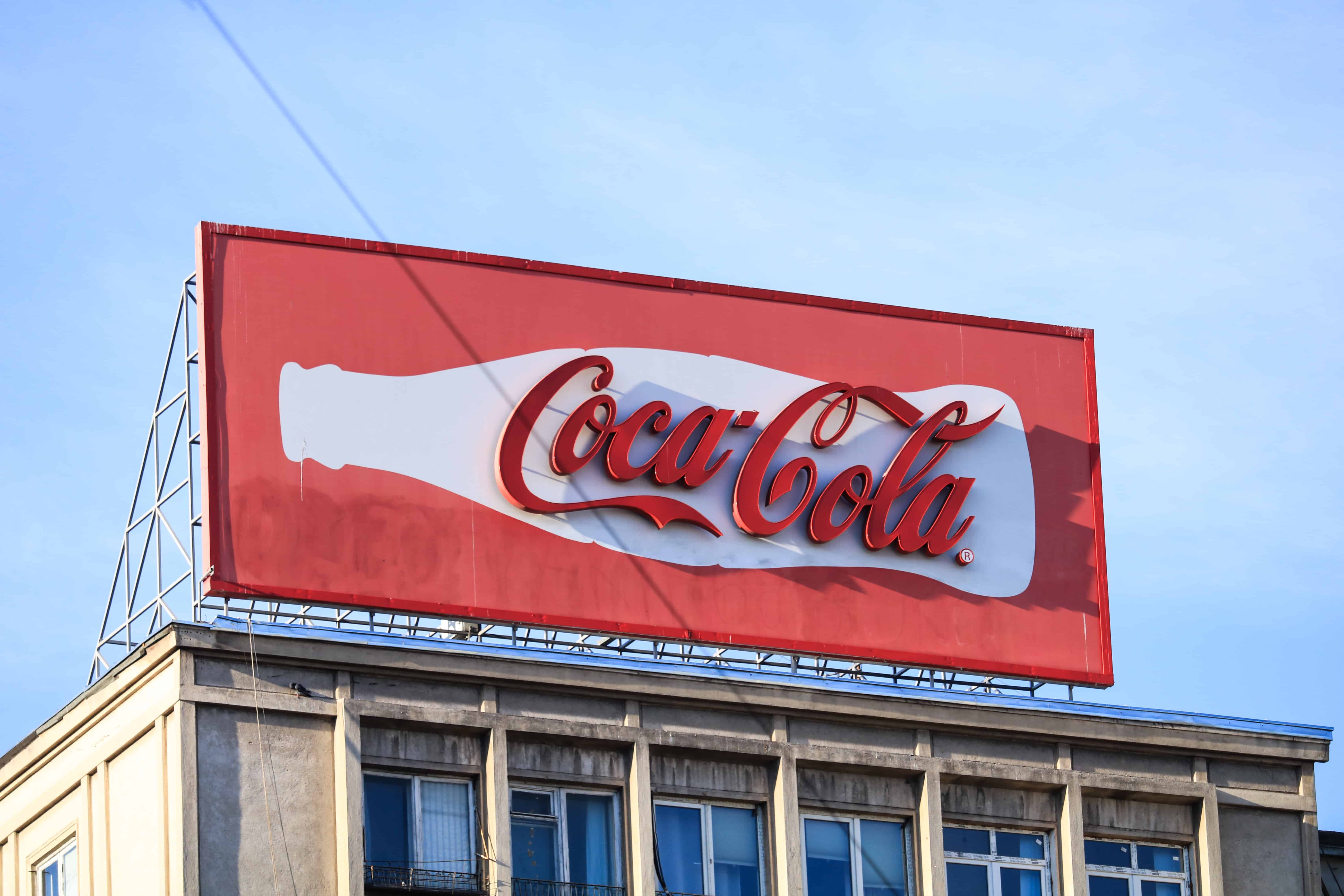
KO is the stock code of Coca-Cola on the New York Stock Exchange.
The company’s stock is listed on the NYSE and is part of Dow Jones Industrial Average (30 largest companies in the US), the S&P 500 index, the Russell 1000 Index, and the Russell 1000 Growth Stock Index. Accordingly, Coca-Cola’s stock code or ticker symbol is KO.
Coca-Cola's stock value continues to grow since the IPO.
Coca-Cola’s Initial Public Offering was on Sept 5, 1919, with an IPO price of $40 per share. Simultaneously, the company released dividends and its stock price also rose in value with an 11-time stock split. With this in mind, a $1,000 investment on Coca-Cola since its IPO price would have been over $450,000 today. Furthermore, if you just recently invested in the company around 10 years ago, the $1,000 would have been more than $2,500 in today’s market value.
Berkshire Hathaway is the largest shareholder of the Coca-Cola Company.
The Coca-Cola Company is now publicly-traded. In other words, the owners of the Coca-Cola Company are its shareholders. Berkshire Hathaway is the biggest shareholder of the Coca-Cola Company, representing 9.39% of the company. Furthermore, Vanguard Group owns 6.56%, Blackrock Inc. 5.68%, State Street Corporation 3.98%, and Capital World Investors 3.35% are among the top shareholders of the company.
Warren Buffet started to accumulate the shares of Coca-Cola in 1988.
Warren Edward Buffett is an American businessman, investor, and the chairman and CEO of Berkshire Hathaway. In the year 1988, Warren Buffet decided to buy more than $1 billion of Coca-Cola shares, equivalent to 6.2% of the Coca-Cola Company.
The Black Monday Stock Market Crash hit most companies including Coca-Cola.
The 1987 stock market crash, also known as the Black Monday on October 19, 1987, triggered Dow Jones Industrial Average to fell 508 points. It is the biggest one-day stock market drop in history. At that time, Warren Buffet invested in the stock market, Coca-Cola in particular, and injecting his theory – “be greedy when everybody else is fearful”.
Warren Buffet's risk meets reward.
The legendary investor Warren Buffet may have realized that the Coca-Cola shares are already oversold and undervalued. After the stock market crash, Coca-Cola stock plummetted so hard along with other companies. He was convinced that Coca-Cola is a great company with great value, and was able to endure the competition and was poised to recover. As a result, Berkshire Hathaway bought as many shares as they could and became the biggest shareholder of the Coca-Cola Company. It was also one of Warren Buffet’s best investments of all time.
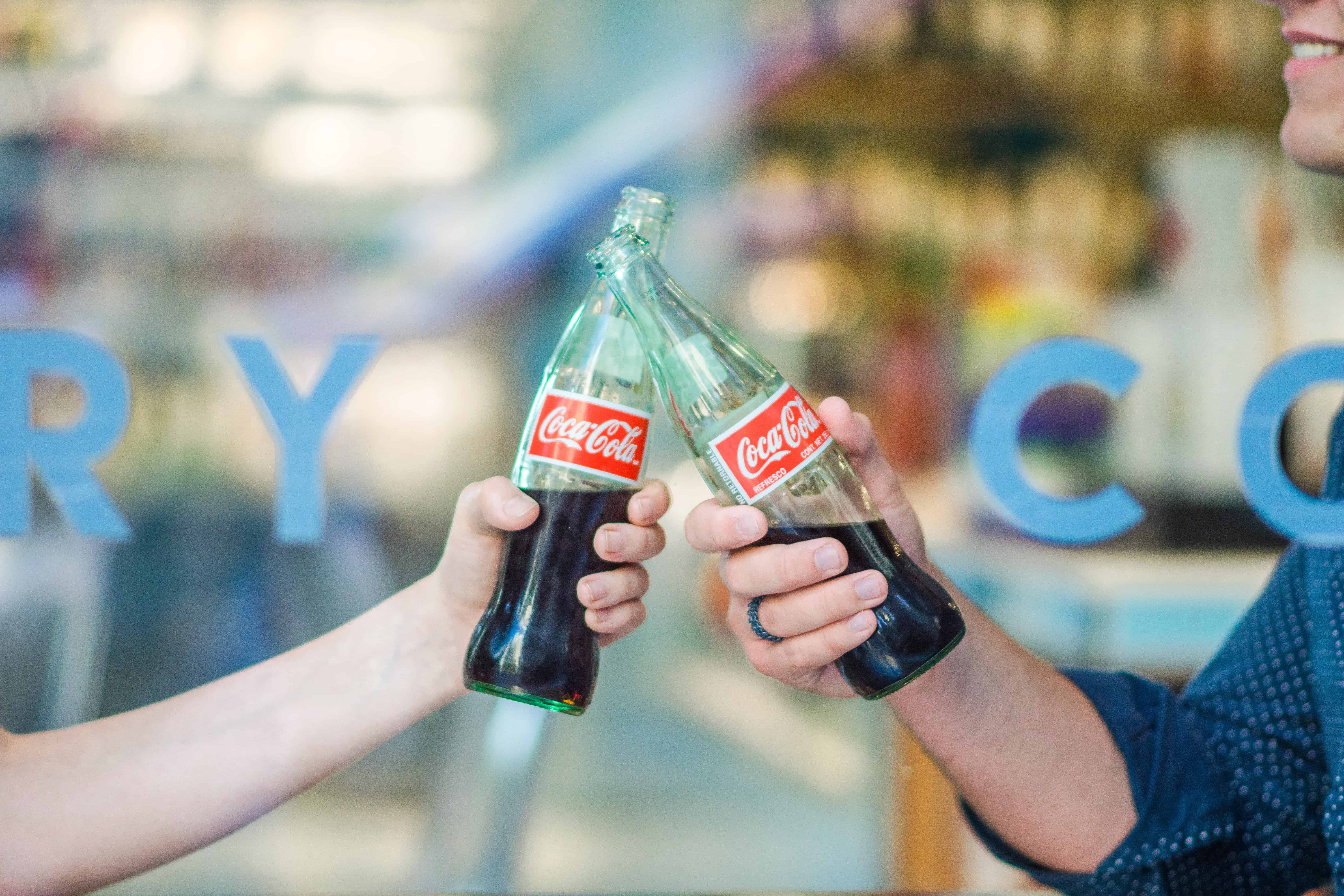
Every day, Coca-Cola sells 1.9 billion drinks.
One of the most widely distributed products on Earth is definitely Coca-Cola products. Currently, Cola-Cola sells 1.9 billion bottles of soda every day. This means 3.1% of all the beverages consumed around the world are Coca-Cola products. Did you know that there are only 2 countries that do not sell Coca-Cola? They are North Korea and Cuba.
The Coca-Cola production in Cuba ceased in 1962.
Coca-Cola opened one of its first bottling plants in Cuba in the year 1906. However, the production ceased in 1962 due to the trade embargo (a government order to restrict the trade of certain goods with a foreign country) right after Fidel Castro took over the country. However, as of today, some tourists in Cuba spotted a Coke in some resorts. Nevertheless, Cuba has its version of Coke called Tukola.
According to media reports, they saw a Coke in North Korea.
North Korea is also known to be a “Coke-free” zone. However, according to media reports, they have spotted Coca-Cola products in some restaurants in Pyongyang, the capital of North Korea. While it may be true, Coca-Cola admits that any drinks that are being sold in either North Korea or Cuba are being smuggled in the black market. Hence, the products did not come from the main channels.
Coke can do cleaning wonders on the toilet bowls.
Coca-Cola can clean toilet bowls. Yup, you didn’t read that wrong.
Indeed, the fizzy soda can remove hard-to-clean stains in a toilet bowl. By containing Coke in a spray bottle or simply pouring directly on the coating of the toilet bowl, it will soften the stains. Furthermore, allow Coke to sit for several minutes or hours and it will enhance its effectiveness. Finally, before flushing, use a toilet brush to scrub away the stains.
Coke removes grease on your clothing.
Coke has an ingredient called phosphoric acid. This ingredient can remove grease on clothing. Moreover, using a can of Coke on your laundry together with the regular laundry detergent will do a good job in grease removal. However, if the grease is tough to remove, apply Coke directly to the stain and let it soak for up to 30 minutes before tossing it in a regular wash cycle.
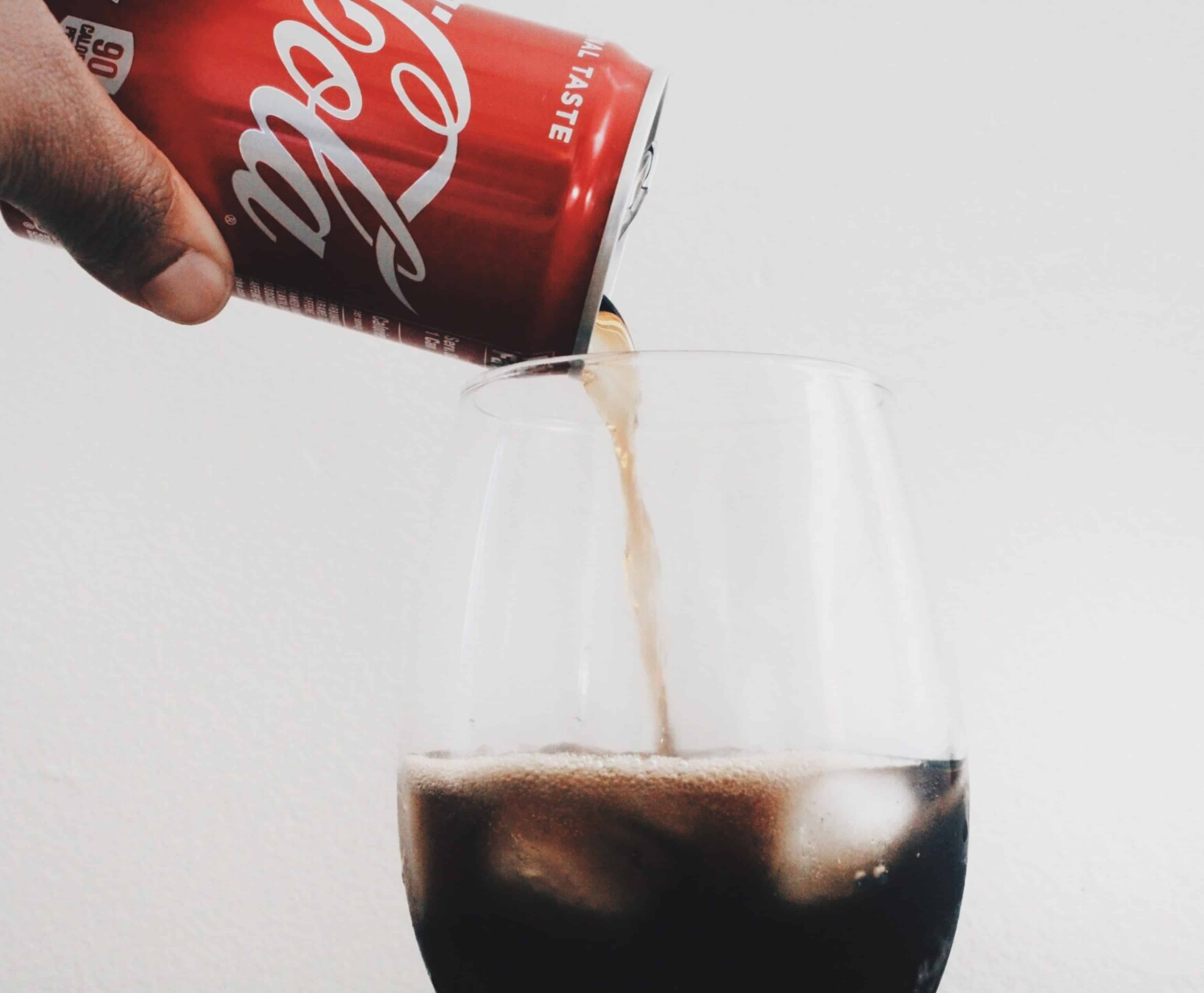
Coke strips the rust from hardware tools.
Coke strips the rust from nuts and bolts as well as the tools. By putting Coke in a spray bottle and misting on the rusty area will do the job for rust the removal. Furthermore, using a scouring pad, scrub, or even an aluminum foil on the affected surface will do the finishing touches for the nuts and bolts. In like manner, the same process is applied to the hardware tools. However, it is better to put them in a container filled with Coke overnight if the rust is heavy.
Coke removes baked-on grease from pots and pans.
Having a hard time removing the grease on pots and pans? Coke is an effective partner in the kitchen as well. By simply pouring Coke to the greased pot or saucepan for 30 minutes will help separate the grease from it. Furthermore, if the grease is really tough, it’s better to put it on a burner on low heat with Coke for a few minutes.
Coke removes bugs from windshield.
Coke easily removes the bugs from a dirty windshield. By pouring Coke lightly on the parts of the windshield and allowing it to sit for a minute, thereafter wipe it away with a wet microfiber towel will do the finishing touches. Drivers who don’t have the right cleaning agents as of the moment can use this simple strategy if bugs should mess on your car’s windshield.
Only use Coke for cleaning at your own discretion.
Equally important, the Coca-Cola company does not promote Coca-Cola as a cleaning product. However, they are not also denying that using it as a cleaning agent is also a good alternative. With this purpose in mind, each individual should only use Coca-Cola as a cleaning agent at their own discretion.
The secret formula of Coke is hidden in a vault.
Even though a variety of recipes and experimental recreations have been made, the current formula of Coca-Cola remains to be a trade secret. Moreover, it is believed that the secret formula of Coca-Cola is written in a piece of paper hidden in a vault in the United States in SunTrust Bank in downtown Atlanta. Today, only a few staffs know the secret formula for Coca-Cola.
Coca-Cola has a special arrangement with the DEA.
Since the traditional recipe of Coke contains cocaine, the Coca-Cola company has a special arrangement with the Drug Enforcement Agency which allows them to import dried coca leaves from Peru and Bolivia. Furthermore, a company from New Jersey extracts the cocaine in the leaves for medical purposes and sends the legal remainder to Coca-Cola.
Frank Mason Robinson created the logo of Coca-Cola.
John Pemberton’s bookkeeper, Frank Mason Robinson, created the iconic logo of Coca-Cola. In particular, the bookkeeper came up with the name and chose the logo’s distinctive cursive script in the year 1885.
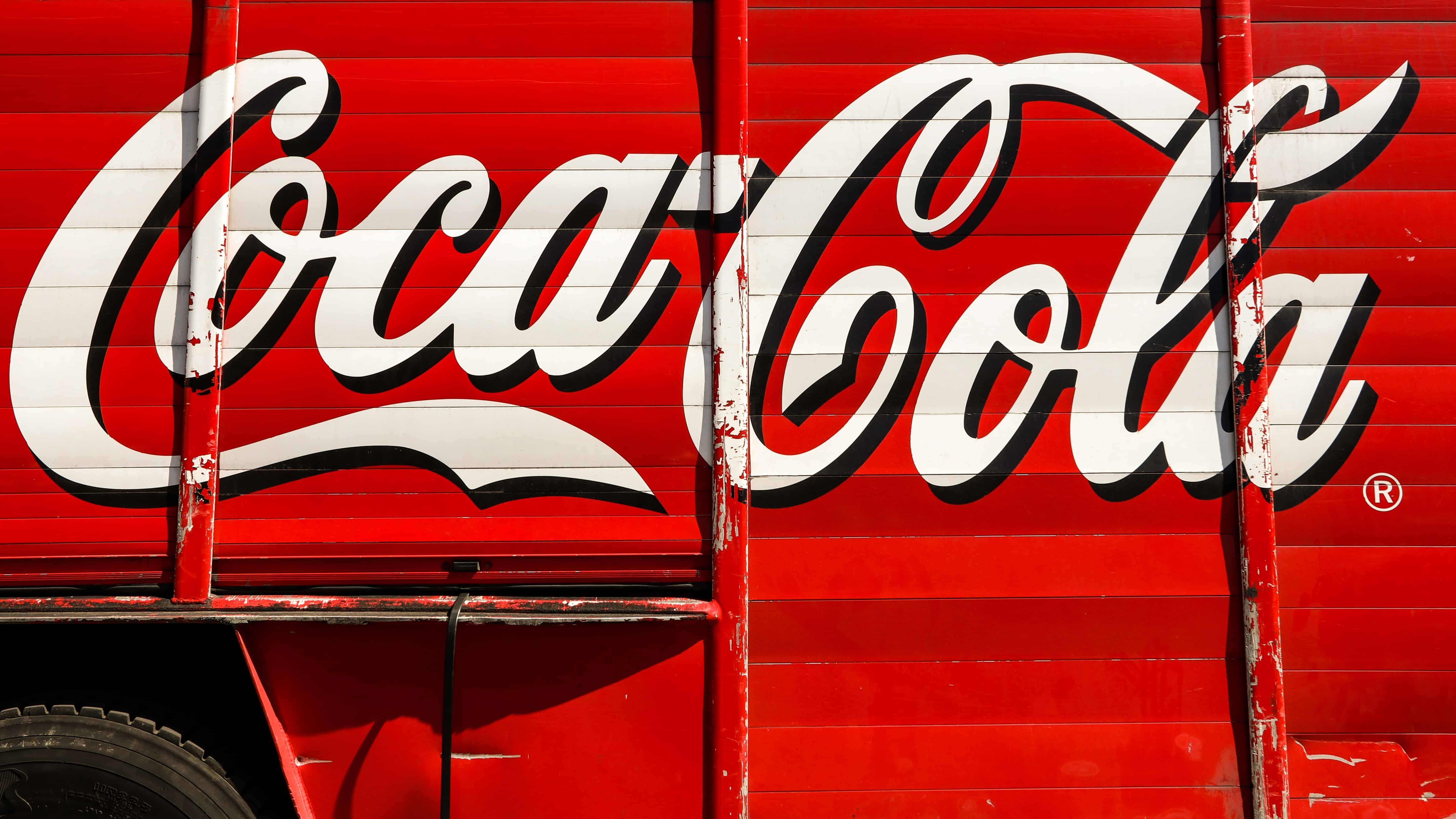
Coca-Cola needs 300,000 tons of aluminum every year.
Most of the Coca-Cola products are sold in aluminum cans. As a result, the Coca-Cola company consumes more than 17% of the produced aluminum in the United States. Moreover, the company uses 300,000 tons of aluminum for the cans every year in the United States alone.
Coca-Cola uses over 3 million tonnes of plastics every year.
Besides aluminum, Coca-Cola is also known to use plastic bottles for its beverages. With this in mind, the Coca-Cola Company is one of the biggest plastic polluters in the world. Coca-Cola uses over 3 million tonnes of plastics year after year and the company admitted that they have no plans to reduce the usage of plastic bottles as of the moment.
Coca-Cola has received minor and major criticisms.
Over the years, the Coca-Cola company undergoes minor and major criticisms such as the bad health effects of drinking soda, environmental issues, animal testing, employee issues, and economic business practices. However, the company has always been professional about the matters and they are solving them accordingly.
Pepsi turned down an under-the-table offer from a high-level Coca-Cola employee.
Coca-Cola and Pepsi are fierce rivals. In 2006, 3 staffs of Coca-Cola tried to take advantage of their knowledge and reached out to Pepsi and tried to sell the secret ingredients of Coca-Cola for $1.5 million. However, Pepsi turned down the offer. Instead, Pepsi reported them to Coca-Cola and the FBI. It is said that it was a high-level employee mailed the executives at PepsiCo, offering “very detailed and confidential information” in exchange for cash.
Coca-Cola shares its blessings through their foundation.
Coca-Cola shares 1% of its operating income every year through the Coca-Cola Foundation. The philanthropic organization aims for several important core values—entrepreneurship, education, conservation, recycling, and youth development. Since inception, the foundation already contributed more than $800 million to numerous charitable matters.
Was this page helpful?
Our commitment to delivering trustworthy and engaging content is at the heart of what we do. Each fact on our site is contributed by real users like you, bringing a wealth of diverse insights and information. To ensure the highest standards of accuracy and reliability, our dedicated editors meticulously review each submission. This process guarantees that the facts we share are not only fascinating but also credible. Trust in our commitment to quality and authenticity as you explore and learn with us.
